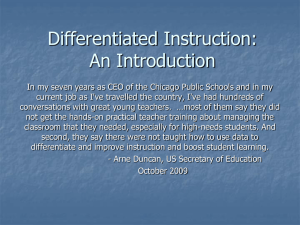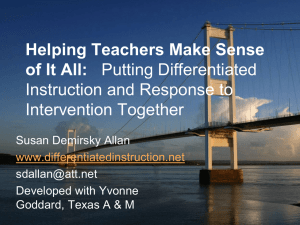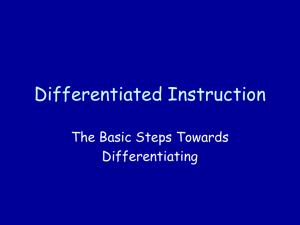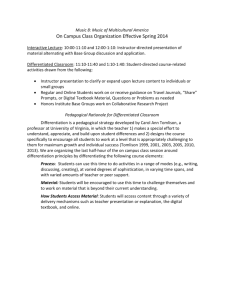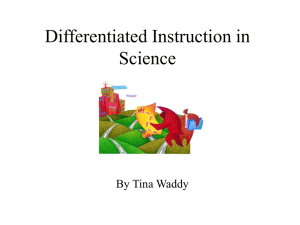Presentation - GeorgiaStandards.Org
advertisement
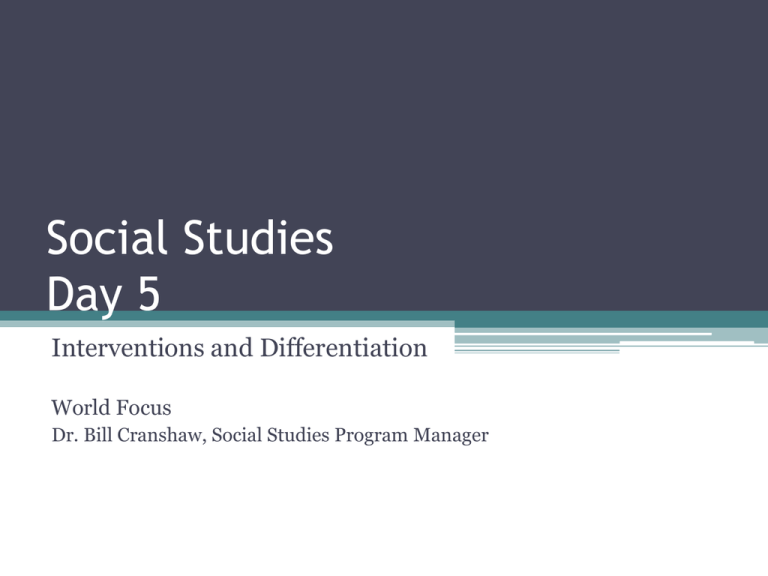
Social Studies Day 5 Interventions and Differentiation World Focus Dr. Bill Cranshaw, Social Studies Program Manager Changing our pedagogy •NOT AGE OR EXPERIENCE RELATED! Day 5 Overview • • • • • • PLU discussion Updates from Systems Social Studies DOE Updates Brief review days 1-4 Intervention Pyramid Differentiation in Social Studies Group Norms and Housekeeping Group Norms: • Ask questions ▫ When they occur ▫ Are no dumb questions • Work toward solutions ▫ Generally there are no right answers ▫ There is no state list of official concepts, tasks, or correct units • Honor confidentiality ▫ Discussions remain in training room Housekeeping: • Parking Lot ▫ ▫ ▫ ▫ Questions Concerns Needs Use yellow stickies • Phone calls ▫ Please restrict to emergencies • Restrooms ▫ Use as needed Professional Learning Units (PLUs) • Local systems award PLUs ▫ MUST bring form to sign FROM SYSTEM ▫ DOE does not provide PLU forms • Trainer will ONLY sign forms at end of day ▫ If you need to leave early for any reason, trainer will only sign for time you were actually in training • CANNOT sign forms retroactively • All information was in training letter that went to systems on June 13th, 2007. Group Discussion: Local System Updates • Take a few minutes to introduce yourself and get to know the teachers at your table. • Share with your group: ▫ How did your system handle GPS training last year? Are there plans to change this year? ▫ What organization is your system using for the curriculum (locally developed, DOE, other)? i.e., curriculum map, pacing, tasks, etc. • Please complete the survey on pg. 27 7 Online Training • • • • Available through www.georgiastandards.org At no cost to systems Click on “Training” in the top right corner Essentially follows the state face to face training that you are receiving today ▫ Intended to be a supplement to face to face training, NOT A SUBSTITUTE ▫ If you choose to use this option, you will become the on-line facilitator Feedback and follow up with participants very important Day 6 • EXTREMELY important that you bring student work samples • Should be from a culminating performance task • Will work better if you have multiple samples • Written work is easiest logistically, but it does not have to be written DOE Updates DOE GPS Updates • 6-8th Grade, World Geography, American Government/Civics, Economics, World History, United States History are ALL GPS • Tests have been developed and aligned with GPS • CRCT and EOCT are purely based on GPS material • GHSGT will be dually aligned • Will be converting 2 electives to GPS • Adding more tasks • Developing interventions for tasks DOE GPS Updates: Frameworks • Several units posted for each GPS course 6-12 • Remaining units in development and will be posted by end of semester • www.georgiastandards.org • Click on “Social Studies” and click on “frameworks” What’s In A Framework? • Essentially, everything that was discussed last year in training • All courses have a curriculum map, consistent themes and enduring understandings (even through different grade levels), balanced assessment plan, and a sample performance task with rubric and resources • Sample units are on page 28 and 35 of your Facilitator’s Guide Graduation Rule • Old Rule ▫ Different diplomas and requirements (CP or TC) ▫ 22 or 24 credits, if want with distinction ▫ Social Studies US History 1 World Area Studies 1 (CP World History required) American Gov’t ½ Econ ½ • New Rule ▫ Single diploma with single set of requirements ▫ 23 units all students ▫ Social Studies US History 1 World History 1 American Gov’t ½ Econ ½ May teach AG and Ec for 1 unit of credit. EOCTs • US History and Econ ▫ No plans at present to add any more • Are completely based on the GPS • Study guides ▫ Only QCC are posted, DO NOT use!! ▫ GPS are being developed, but not finished • Content Descriptions ▫ Are complete and posted for Social Studies • Econ EOCT ▫ Mid-semester administration grades in Dec ▫ Insufficient data to set standards until Dec. EOCT Domain Percentages Standards 1-5 Standards 6-10 Standards 11-14 Standards 15-20 Standards 21-25 GHSGT • Domains ▫ ▫ ▫ ▫ ▫ US History to 1865 (26%) US History from 1865 (25%) World History (18%) American Government (18%) World Geography (13%) • Core Skills are gone ▫ Are to be taught in context ▫ Will be assessed as applicable to the content ▫ Will not be reported separately Social Studies Training Videos • Developed Unit 1 ▫ Explains the importance of teaching Enduring Understandings at the beginning of the course ▫ Shows actual classroom instruction • Plans ▫ Videos demonstrating content unit instruction ▫ Production early next year Review of Days 1-4 Standards Based Education Model (one or more) Standards Elements Stage 1 Identify Desired Results (Big Ideas) Enduring Understandings Essential Questions GPS Skills and Knowledge All above, plus Tasks Student Work Teacher Commentary All above Stage 2 Determine Acceptable Evidence (Design Balanced Assessments) (To assess student progress toward desired results) Stage 3 Plan Learning Experiences and Instruction (to support student success on assessments, leading to desired results) Importance of conceptual teaching • Important to give students the BIG ideas and enduring understandings at the beginning so they can organize new knowledge • Must teach them initially and continually use throughout the course • Every lesson should reinforce a concept/enduring understanding • EUs must be consistent in a course Group Discussion: Concepts in your classroom. • How are you implementing conceptual teaching this year? • What concepts are you using? • How are you ensuring student understanding? • What techniques/strategies have you tried to help students organize the knowledge? • Please prepare to share any helpful information with the group. Pyramid of Interventions The Pyramid of Interventions • Focuses on 3 questions: ▫ Are students learning? ▫ How do we know that they are learning? ▫ What are we prepared to do when they do not learn? • The idea is to not wait until students have large gaps in their learning that are almost too great to overcome. • Pro-active vs. re-active Tier 1: Standards Based Classroom Learning • Should be happening for ALL students in ALL classrooms • Basic implementation of GPS through a standards based approach using best practices • For Social Studies, this means conceptual teaching, varied assessments, and measuring understanding through performance tasks. Tier 2: Needs Based Learning • Begins to answer the question: “What are we prepared to do when they do not learn?” • Pro-active measures that address known trouble areas OR known “easier” areas for higher ability students. For students having difficulty • More time on trouble areas • Pre-planned tutoring • Pre-planned review material for students that have problems in certain areas For students “ahead of schedule” • Planned enrichment activity • Prepared modified curriculum • Student led tutoring or student led teaching • The same student may fall in both categories as the year progresses! Social Studies Example • Identified trouble area: Analyzing Primary Source Documents • Major Issue: Reading level, analytical thinking • Trouble for: ESOL, sub-level readers, linear thinkers • Easy for: High level readers, critical thinkers Social Studies Example • • • • Tier 2 Intervention ideas Have shorter versions for lower readers focusing more on major ideas. Pair students high/low for help Have “modern day” versions prepared Have high end students work alone and have a backup assignment for enrichment ready to go Tier 3: Student Support Team Driven Instruction • This is where students begin being referred to specialized teams (SST). • More individualized instruction • May have completely different assessments • Different from tier 2 in terms of specificity and individualization • Typically includes a system-level plan Tier 4: Specially Designed Instruction • Should be the fewest number of students • If tiers 1-3 are used effectively, fewer students will require this level • Gifted Ed or Special Ed self-contained classes are an example • Tier 4 can take place in the general ed classroom as well. • Takes tier 2 to a much larger level • DOES NOT MEAN CHANGING CURRICULUM!!!! ▫ All students are expected to meet standards Developing tier 2 interventions • Select 2 areas in your course that cause instructional problems except READING. • On a piece of chart paper write the following: ▫ The area that causes problems. ▫ Identify the specific difficulty (i.e. reading level) ▫ AT LEAST 2 interventions you use/could use to solve that problem. • Repeat those bullets for BOTH areas of concern you choose. Look at the entire curriculum, not just what you are currently teaching. • Example on page 43. Differentiation Strategies Group Activity: Define differentiation. • In your group define the word “differentiation”. • Prepare it as though you were about to explain it to a group of non-teachers. • Share with the large group. What is Differentiation? Differentiation can be defined as a way of teaching in which teachers proactively modify curriculum, teaching methods, resources, learning activities, and student products to address the needs of individual students and/or small groups of students to maximize the learning opportunity for each student in the classroom. --Facilitator’s Guide for At Work in the Differentiated Classroom, 103. What is Differentiation? • Differentiation adapts what we teach, how we teach to the ways students learn, and how students show what they have learned based on the readiness levels, interests, and preferred learning modes of students. • Differentiation is classroom practice that looks eyeball to eyeball with the reality that kids differ, and the most effective teachers do whatever it takes to hook the whole range of kids on learning. --Facilitator’s Guide for At Work in the Differentiated Classroom, 103, 113. Essential Principles of Differentiation 1. Good Curriculum Comes First 2. All Tasks Should Be Respectful of the Learner 3. When in Doubt, Teach Up 4. Use Flexible Grouping 5. Become an Assessment Junkie 6. Grade for Growth --Tomlinson & Eidson, Differentiation in Practice, Grades 5-9, 13-15. Why Do We Differentiate? The key reasons for differentiating the learning experience are: access to learning motivation to learn efficiency of learning --Tomlinson, The Differentiated Classroom Access to Learning Students cannot learn that which is inaccessible because they don’t understand. --Tomlinson, The Differentiated Classroom Motivation to Learn • Students cannot learn when they are unmotivated by things far too difficult or things far too easy. • Students learn more enthusiastically when they are motivated by those things that connect to their interests. --Tomlinson, The Differentiated Classroom Efficiency of Learning • Students learn more efficiently when they have a suitable background of experience. • Students learn more efficiently when they can acquire information and express understanding through a preferred mode. --Tomlinson, The Differentiated Classroom What Do We Target to Differentiate? We determine what to differentiate by assessing the readiness interests learning profile of particular students or groups of students How Do We Differentiate? Content Process DIFFERENTIATION Product Learning Environment Differentiating Content (Pg. 45 In FG) • Ideas, concepts, descriptive information, and facts, rules, and principles that the student needs to learn. • Content can be differentiated through depth, complexity, novelty, and acceleration. •DOES NOT MEAN CHANGING THE CURRICULUM!!!!!!!! Readiness testing Concept based teaching Learning Contracts Learning styles and Multiple Intelligences Interest based mini lessons Curriculum compacting Multiple and/or supplementary texts Small group Technology Varying rate of learning and complexity Time Line intervention Paleo 8000 BCE Archaic Woodland Mississippian Woodland Mississippian 1500 BCE 300 CE bian ange Archaic Columbian Ex. Paleo 1492 CE Differentiating Process (Pg. 45 In FG) • Presentation of content • Learning activities for students • Questions that are asked, • Teaching methods and thinking skills that teachers and students employ to relate, acquire, and assess understanding of content Student Choice Tiered Curriculum Mixed Readiness Grouping Learning Contracts Cubing Learning Stations Similar Readiness Grouping Choice of Work Arrangement Anchor Activities Varied Journal Prompting Differentiating Products (Pg. 45 In FG) • Products are the culminating projects and performances that result from instruction. • They ask the student to rehearse, apply, or extend what s/he has learned in a unit. • A product or performance provides the vehicle that allows students to consolidate learning and communicate ideas. Tiered products Student choice Interest-based investigations Independent study Mentors Differentiating Learning Environment (Pg. 45 In FG) • The way the classroom looks and/or feels • The types of interaction that occur • The roles and relationships between and among teachers and students • The expectations for growth and success • The sense of mutual respect, fairness, and safety present in the classroom. Class Meetings Shared Decision Making Response Journals Responsibility for Learning Established Protocols WHY DIFFERENTIATE? WHAT SHOULD I TARGET WITH DIFFERENTIATION HOW DO I TARGET READINESS, INTEREST, and LEARNING PROFILE? ? Provide students better ACCESS to information Improve student MOTIVATION Use the most EFFICIENT method of learning A student’s READINESS to learn the information A student’s INTERESTS outside the classroom A student’s LEARNING PROFILE Varying CONTENT by depth, approach, and time allotted (not changing curriculum!) Altering the PROCESS by which students receive information Allowing for different PRODUCTS that demonstrate understanding Changing the LEARNING ENVIRONMENT at times to allow students more control of their own learning The Equalizer Concrete to Simple to Basic to Fewer facets to Smaller leaps to More structured to Less independence to Slower abstract complex transformational multi-facets greater leaps more open greater independence to faster Tomlinson,1995 Group Activity: Differentiation in practice (small groups 3-4). • In your table groups, analyze the differentiated tasks provided on the Guided Practice handout (Page 48). • There are three sample tasks/activities and for each one there is a differentiated version. • Discuss and write what (readiness, interests, learning profile) and how (content, process, product, learning environment) differentiation is taking place. Group Activity: Differentiation in practice (small groups 3-4). • Using a performance task provided on pages 50-54) your group will develop intervention strategies. • You will get four “personality cards” that describe four students; for each student your group will identify appropriate interventions. • Recreate your table on chart paper and post • THINK ABOUT LESSONS LEADING UP TO TASK!!!!!! • How does the intervention help the student to demonstrate their understanding of the EU? Enduring Understandings • The student will understand that ▫ 6th & 7th & WH & WG (culture):the culture of a society is the product of the religion, beliefs, customs, traditions, and government of that society. • WH & WG (location): that location affects a society’s economy, culture, and development. • WG (HEI): humans, their society, and the environment affect each other. A True/False Quiz: What Does Differentiated Instruction Look Like? • Turn to page 61 in your Facilitator’s Guide • Mark each item T if it is TRUE for a differentiated classroom or F if it is FALSE for a differentiated classroom. • After you have responded individually, think/pair/square to compare your answers to the others in your table group. • When you disagree, discuss your various points and attempt to reach consensus. • Be prepared to share important points with the whole group. Day 6 • EXTREMELY important that you bring student work samples • Should be from a culminating performance task • Will work better if you have multiple samples • Written work is easiest logistically, but it does not have to be written Contact Information • World Focus: (Program Manager) ▫ Dr. Bill Cranshaw ▫ wcransha@doe.k12.ga.us ▫ 404-651-7271 • US Focus: ▫ Chris Cannon ▫ chcannon@doe.k12.ga.us ▫ 404-657-0313 • 3-5 Focus: (Program Specialist) Marlo Mong mmong@doe.k12.ga.us 404-463-5024 • K-2 Focus: Sarah Brown sbrown@doe.k12.ga.us 404-651-7859

